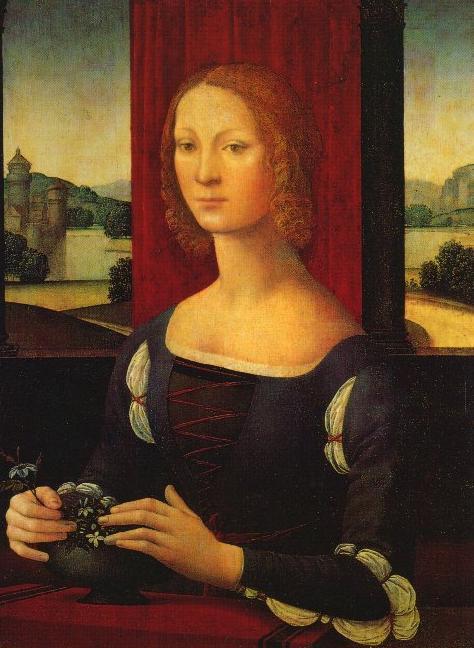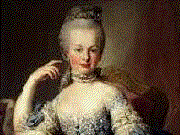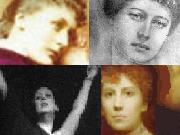Womania
| Caterina Sforza |
| Table of Contents |
|
Books on eBay ???
Why not!
Click the picture below!
Enter the BOOKS category and
Find fun and bargains!


Caterina got engaged to Girolamo Riario—a 27-year-old nephew of the Pope Sixtus IV.
As the shape of her future loomed out of the mist, Caterina turned to the revered classical and Christian texts. Her education conformed to humanist ideals—from the mechanical recitation of Latin verses to the earnest concern with virtù, that is, the shaping of a thoroughly educated person, adept in the art of reasoning with elegance, order, and profundity.
However, Virgil, Terence, Horace, Cicero, and Ovid never did strike her fancy. Nor could she master the then fashionable female accomplishment of playing the lute. But she listened with fascination to the tutors when they related the deeds of famous men and women of history. Caterina enjoyed to ball-playing, horseback-riding, and dancing.
Girolamo’s period of education had been short and had long since passed. He now must show his skill and judgement as the right-hand man of the pope. Fortunately, his position proved a light burden for him. In the mid-seventies, Italy hardly heard war cries. The papacy kept closer to Naples in its policies. Naples with its restless expansionism found a congenial ally in the pope who strove above all to aggrandize the Rovere and Riario families.
The new political structure also fitted well with the bitter hatred between the Medici and Riario. This shift in Italian politics would eventually burn its traces into history, but for the time being it hardly disturbed Girolamo’s almost effortless enjoyment of power, glory, and ceremonial tasks.
Girolamo gave little thought to Caterina. After all, she was merely a nine-year-old child while he kept himself busy as the pope’s right-hand man. There was furthermore no need to cultivate affections because none existed. No letters from Girolamo to Caterina remain because, most likely, they never wrote. Girolamo, however, did communicate with Roman women. Although he lacked the imagination and the vigor of a libertine, he appreciated female company sufficiently to produce a son, Scipio.
Thus the worlds of the prospective groom and bride remained separate but resembled each other. Caterina found herself in the midst of preparing for a life designed by everybody else but herself. Girolamo savored the glories of a position that he owed least to himself. Then, a few days before the year 1476 expired struck a thunderbolt from the blue sky. The two worlds met and the years of uneventful waiting ended.
On December 26, 1476, an incongruous trio of assassins stabbed Duke Galeazzo Maria Sforza to death.
The assassins turned out a youth who dreamed of being a second Brutus or Cassius, an impoverished opponent of the Sforza, and a Visconti outraged by the duke. The inspiration for the deed and the skill with the dagger had been provided by the duke’s former tutor, Cola Montana, whom the duke had publicly humiliated. Vengeance was taken swiftly and fiercely on the conspirators, but Galeazzo was dead and the news traveled fast.
When the news reached the pope, Sixtus IV exclaimed in horror: “The peace of Italy is dead.” Indeed, it went dead, since with Milan facing a struggle for influence between Galeazzo’:s brothers and his infant son, the Italian balance of power became seriously jeopardized. What the Rovere-Riario also realized was that their influence in Milan now was shrouded in uncertainty. Decisive action alone could help.
The pope and Girolamo now wanted to hurry the final conclusion of the marriage contract by the performance of the actual wedding. In January 1477, Bona wrote Girolamo that his bride and her dowry were at his disposal. Girolamo found it impossible to get away from Rome for the occasion. Cardinal Legate Mellini traveled to Milan to perform the wedding.
In Milan, where official sadness hushed all sounds of joy, Caterina and Girolamo were irrevocably joined in the proxy marriage.
Only the close relatives and the representatives of Girolamo witnessed the wedding, which marked the beginning of Caterina’s own career. She was ready to shed the role of mere pawn in the game of politics being played by the Rovere-Riario and the Sforza and to grow into one of the players.
Although the groom didn’t show up, Caterina was delighted by the sight of all the new places on her way to Rome where her groom waited for her. While the captain of Reggio overslept and thus made Caterina arrive unheralded, Modena sent all its dignitaries to greet her, and at Bologna the Bentivoglio welcomed, feasted, and sheltered her, and even accompanied her on her departure. Such hospitality cost the city of Bologna a fortune. Caterina joyously savored the demonstrations of affection each of these cities dutifully staged for the daughter of the duke of Milan, wife of the vicar of Imola, count of Bosco, and most powerful of the papal nephews. Nothing in her education or experience had yet taught her the essential difference between genuine and official expression of affection.
Young and innocent as she was, Caterina had nevertheless absorbed the lesson that, to dominate, she must display her status. When she neared Imola, stopping for rest and food at Castel San Pietro, she put on a startling good-brocade dress, a brown cloak, extravagant gloves and precious jewels. Thus adorned, she accepted the greetings of “her” town, Imola, which she reached on May 1. Everybody was in the streets, shouting or just gazing. The magistrates presented her with the keys of the city, children sang and recited verses, and allegorical groups were staged along her route of entry. Finally, in front of the Riario palace, she found a great pavilion gaily decorated with flowers, draperies, banners, and the coats of arms of the pope, the Riario, and the Sforza.
When Caterina came to rest in her chamber that evening, her heart was exuberant with joy. She had failed to notice how dreary, small, and provincial a city Imola was compared with beautiful Milan. Imola was only a forestate. Caterina looked forward impatiently to meeting her husband and to seeing Rome. For one week and then another she waited for a word from Rome. It never came. Bona of Savoy in Milan knew the reasons through the Milanese orator in Rome. The city was ravaged by partisan strife. Some men had tried to assassinate Girolamo. And a blistering heat bred a deathly fever. Caterina was supposed to wait in Imola for a betterment of the Roman weather, in politics and in nature. But, unaware of these developments and burning with desire to reach Rome, Caterina showed her characteristic impatience with inaction and left Imola on May 13.
After eighteen days of traveling over mountains and on dusty roads the world of Rome reached out for Caterina. Monsignore Sagramoro, bishop of Parma and orator of the duke of Milan at the papal court awaited her at Castelnuovo, and on the next day the bride finally met her groom, Girolamo Riario.
Clothed in sable velvet and silk and surrounded by an impressive number of attendants, Girolamo greeted Caterina at a way station seven miles from Rome.
Girolamo and Caterina dismounted, shook hands, and exchanged a perfunctory kiss—no sign of great joy, just curiosity on both sides.
The bride could not overcome her shyness, and the groom could not hide his lack of true interest in his young bride. Both also knew that the force which had joined them was dynastic politics. Love would be only incidental.
After a short rest under a cluster of trees, the dusty road called again. But now there were pleasant interruptions to the monotony of travel. To greet Caterina at every quarter of a mile stood prelates, household members of the cardinals, and dignitaries of the city, even the city prefect himself, Giovanni della Rovere. At the Ponte Molle the papal court and the ambassadors of Spain and Naples paid their respects. By the time Caterina arrived at her quarters in the palace of the cardinal of Urbino at Monte Mario, she was once more carried away by her enthusiasm.
In the evening she supped with Girolamo. When he left, Girolamo presented his bride with a pendant beset with jewels worth several thousand ducats.
The next day Caterina entered a most glorious and pleasant life. It was the day of Pentecost, and Rome was in a festive mood. Even the poor had joyous hearts. Caterina rode through the streets to St. Peter’s—old St. Peter’s, which would soon be razed. Around her were the orators of most Italian powers, cavaliers of such noble families as the Orsini, Colonna, and Gonzaga, and countless others, all of them luxuriously attired and on richly decorated robe with gold brocade ornaments, tailored according to the newest fashion with a deep decolletage and decked with numberless jewels.
Throughout the pontifical mass she sat with Sixtus IV and the cardinals on a specially erected scaffold. For three long hours she had time to study her new environment and to master her excitement and shyness. Afterward the Milanese, papal, and Imolese dignitaries went to a chapel in St. Peter’s. There Caterina knelt and kissed the pope’s feet. He in turn blessed and praised her. Then Gianluigi Bossi, Caterina’s chaperon, added to the length of the ceremony by endlessly listing Caterina’s virtues in finely chiseled Ciceronian Latin. His commission ended when Caterina spoke once more the formula of matrimony and received a twenty-five thousand ducat necklace as a memento of the occasion. Caterina kissed the hands of the cardinals, among them Rodorigo Borgia, the future Alexander VI. Politely they promised to be her faithful servants.
After a final blessing Caterina was escorted to the palace of the Orsini on the Campo di Fiori. This time the streets were heavy with the sweet odor of perfumes, while the house facades were hung with draperies displaying the coats of arms of the three families involved.
The day of glory ended with a sumptuous banquet. At five in the afternoon a little child made up as an angel came to Caterina’s quarters and announced dinner. In the dining room Caterina found her husband, members of the most illustrious families, and about two hundred guests. Twenty-two courses were served, and abundant sweets. After every fifth course the banquet was enlivened by such beloved entertainments as a ballet, a danza moresca (“a Moorish dance”, often grotesque), a Florentine dance, children dressed as angels or as hunters “chasing” cooked animals restored to their original forms, classical mythological figures and groups, and Latin declamations.
Her marriage had placed Caterina near the center of the Roman universe with its cardinals, nobles, ambassadors, and humanists. A tournament was staged with all the pageantry quattrocento Rome could master, and Caterina presided over it. She was so intoxicated by all the adulation that she even forgot to write to Bona and Chiara for a while. For a few days she had been the central figure on one of the outstanding stages of Renaissance life—Rome. The world had made its curtsy. Soon it would stand erect and look Caterina straight in the face with eyes that revealed more than tribute to her glory.
Caterina and Girolamo began their life together in Rome.
However, the city retained little of its ancient grandeur, with only a fading medieval facade and none yet of Renaissance splendor. Only its importance as the headquarters of the Holy Mother Church prevented the city from slipping into utter provincialism and thus draining all support from the Roman traders, scholars, artists, tavern-keepers, water-carriers, and even prostitutes.
Sun, rain, and wind gnawed away at the ancient monuments. Many of them stood sadly grandiose in areas now unpopulated and looked down on cattle, sheep, and goats roaming and grazing amongst them. It was a city filled with churches and monasteries, some the mecca of ardent pilgrims, others long neglected and beyond repair. Through the core of the city with its clutter of buildings wound a few wide streets with decent paving. From them branched off narrow side streets, dark and filled with stenches, meandering among churches, palaces, shops, again churches, and finally ending among the vermin-infested shacks of the poor, huddled together at the Tiber River, or in the vast expanse of the unbuilt area surrounding the city.
Girolamo, a citizen of Rome since 1477, asserted his power as the spokesman for the pope over the rebellious nobles of Rome, the Colonna, Orsini, de’Conti, Santa Croce, Savelli, and della Valle, and over the proud city, with its prefects, councils, judges, high-sounding titles with little power to give them substance. Girolamo simply wanted to maintain and strengthen the pope’s position, and with it his own.
In nearly four years as the pope’s main advisor, Girolamo had not markedly grown in insight and maturity. He could be generous and charming, but such moments were much rarer than those in which he abandoned himself to impetuosity and vindictiveness. Even a usually cautious chronicler, after dutifully adulating Girolamo as “most benevolent, merciful and ready to do good”, dared to call him “most greedy for gain and power”.
The fifteen-year-old wife evoked no great praise from her contemporaries.
Her beauty was still a promise. The parts of her face and beauty were not yet shaped into such unity that it would make the observer overlook their imperfections. Her too spacious forehead and overly large and slightly aquiline nose violated the Renaissance ideals of feminine beauty.
On the other hand, her blue eyes, her blond hair, although still combed in a girlish fashion, her graceful swanlike neck, and her well-developed breasts already were cause for compliments. If she acted a bit forward and brash for a young lady, her contemporaries ascribed it to her youthful enthusiasm.
No records tell of the life of Girolamo and Caterina as a couple during the 1470s. The otherwise outspoken Renaissance chroniclers remain silent. There was, of course, no dynastic interests at stake to attract their attention.
The marriage was probably neither worse nor better than others. Politically inspired marriages never aimed to promote the happiness of the two spouses. The true feelings of the twenty-nine-year-old Girolamo toward his girlish bride are shrouded in mystery. Outwardly he played the doting husband. He did not accept Caterina’s dowry, but rather invested it in her name in estates. He even professes “a natural affection for my illustrious consort”l and wished that “she should lack of nothing”.
Only a few months after the wedding, Caterina became pregnant. She hoped that the birth of a son would increase Girolamo’s respect for her. Late in the spring of 1478, Caterina, then sixteen years old, gave birth to her first child, a daughter called Bianca. She was disappointed, because not much was officially made of this event; a girl could not perpetuate the line and therefore Girolamo was not particularly impressed.
Also, he had gone through the experience of fatherhood before when an unknown Roan mistress presented him with a son. There was, too, a first grand political scheme devised at least partially by Girolamo and with which he was already deeply preoccupied.
And what a scheme it was; no less than the doing away with the powerful and famous Medici—Lorenzo “the Magnificent” and Giuliano, his brother. The chief target was Lorenzo, who would eventually be praised in history for his statesmanship and for his eagerness to further the humanist cause, patronize the arts, worship PLato, and write both light verse and serious poetry himself. Girolamo, who was a stranger to the world of literati, saw Lorenzo through the eyes of an ambitious papal nephew.
To Girolamo, Lorenzo resembled a spider which sat in the midst of a vast cobweb centering in Florence, ever busy spinning a denser and deadlier net for his opponents. Lorenzo gave his support to all of the despots who clung like pestering flies to the territory of the Papal States, and who as papal vicars gave lip service to His Holiness and then went their own ways. He was particularly active when he worked to spoil the Riario’s plans of aggrandizement. Which Florentine statesman could look idly on as Riario-Rovere pieced together a domain in the Papal States tightly enclosing Florentine territory?
Giovanni della Rovere had acquired Senigallia and Mondavio and had become the husband of the aging Federico da Montefeltro’s daughter with hopes of becoming the lord of Urbino; Girolamo had taken possession of Imola; and the Riario-Rovere had made every effort to tighten their hold on other cities in the Papal States. Lorenzo de’Medici and Girolamo eyed each other at first with distrust and then with hatred.
The Pazzi Conspiracy
In the spring of 1488 destiny smiled on Girolamo. Lorenzo
had made one enemy too many. The Pazzi, an old, wealthy and
respected Florentine family which had become increasingly
self-confident after having replaced the Medici as bankers of
the pope, had one of its members, Francesco Pazzi, living in Rome.
Unsteady, ambitious, and full of hatred against the Medici, he knew his cause but nit his hour and opportunity. Another man, Francesco Salviatri, named archbishop of Pisa by Sixtus IV without previously consulting Lorenzo de’Medici, burned with frustration and anger at being for three years prevented by Lorenzo from taking office. The hatreds were to nurse a heady plot. Long conspiratory meetings were held. Messages went to and fro between Rome and Florence, where the key man was Jacopo Pazzi, a nervous man who gambled not only his nights but also his days away. The circle of conspirators widened, but the secret was well kept.
Caterina undoubtedly had some notion of what was on foot, but it is extremely doubtful that she was privy to the plot. Her dealings with Lorenzo de’Medici at a later date speak against it.
Sixtus IV remained an enigma. He knew of the undertaking against the Medici, but the Renaissance prince that he had become endowed conspiracy with the same respectability as an open battle. What of the certainty of assassination? We hear that Sixtus IV called Girolamo a brute, because in Girolamo’s vocabulary death had too prominent and too comfortable a place. One could make the fine distinction that Sixtus IV was aware of the possibility of assassination but did not sanction it.
Thus, unmoved by justice or injustice, the fates spun their threads of destiny. They cut one thread on April 26, 1488. During high mass in Santa Maria del Fiore, Giuliano was felled by furious stabs of the daggers wielded by Francesco Pazzi and an associate. But one thread, unexpectedly, went unshorn, that of Lorenzo. The two priests who substituted for a condottiere bungled their job and Lorenzo lived.
The angry people took a mad revenge. The archbishop’s men were thrown from the windows into the street below, and the archbishop himself was hunged in his splendid vestments from one of the windows. To Francesco and Jacopo Pazzi death came with equal swiftness. The two invasion forces ready to strike from Imola and Città di Castello were never able to move.
The Riario escaped unscathed. Girolamo prudently had chosen not to go to Florence, and to be a planner not a doer. However, his partial authorship of the crime was soon known to all the rulers of Italy. The only Riario present in Florence was Cardinal Raffaello Riario, a boy of sixteen years and a nephew of Girolamo. The boyish cardinal had been an innocent decoy to lure the Medici brothers to all kinds of state functions, and Lorenzo mercifully protected him from the fury of the people. The frightened young cardinal of San Giorgio was compensated in many ways for his hours of danger. Among the benefactors was his fifteen-year-old aunt Caterina, who on his behalf interceded with Bona of Savoy and saw to it that he received as a sinecure the rich income from the abbey of Chiaravalle. A sounder investment in gratitude Caterina never made.
The Pazzi conspiracy brought on war. The papal party was indignant that an archbishop had been unceremoniously hanged and above all, though without saying so, that Lorenzo had fused to have himself murdered. Whatever the outcome pf the Pazzi war, Girolamo had earned for himself the unrelenting hatred of one of the most powerful men in Italy. Between the two men stood no longer mere questions of politics, but the murder of Giuliano. The daggers drawn would never be quite sheathed. Nearly to the day, ten years later, murder would atone murder.
The Pazzi war proceeded very much to Girolamo’s satisfaction. The pope and the king of Naples battled Florence, which was only weakly supported by Milan and Venice. The Neapolitan army under Alfonso, son of Ferrante and duke of Calabria, fought well and victoriously. IN addition, Federico da Montefeltro, duke of Urbino and most famous of the condottieri, had been hired to command the papal troops.
Against these the Florentine alliance had only inferior forces under Duke Ercole d’Este of Ferrara. Girolamo had no need to exert his courage, his money, or his wit. He did, however, concern himself with the protection of Imola. Even there he had found able help in the person of Count Gian Francesco Mauruzzi, best known as Tolentino. The latter, a prudent man and experienced soldier, had replaced Domenico Ricci as governor of Imola. Girolamo and Caterina de’Medici made good use of the now vengeful Taddeo Manfredi. Tolentino strengthened the fortress system in and around Imola. Above all, he won the support of the Imolesi, and the city remained in Riario hands.
When the winter came, papal policies seemed to have succeeded. The Florentines were badly beaten. For a few months Caterina had a cheerful husband.
| Copyright Akira Kato About this author:
|

|
































